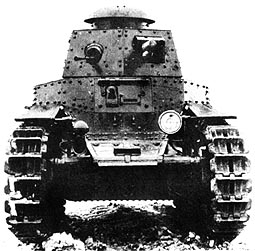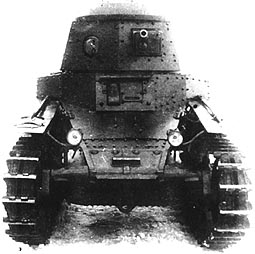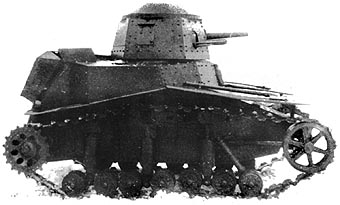| The MS-1 Small Escort Tank |
|---|
|
|

The Malyi Soprovozhdeniya (MS)-1, which later received the "T-18" designation, emerged as the first Soviet production tank. The name falls under the mid-1920s Soviet classification that categorised tanks into "Small," "Main," and "Maneuverable", the "Malyi Soprovozhdeniya" means Small Support. Please notice that according to the Soviet nomenclature of that time, the MS-1 wasn't light tank but small support tank. In May and June 1926, a three-year plan for tank production was developed, based on a concept of a breakthrough of the 10-km frontline that is defended by two foe's infantry divisions. A number of foreign armoured fighting vehicles were analysed as a possible basis for a mass-produced Soviet tank by a special council of RKKA High command, GUVP and OAT held in September 1926. The French Renault tank classified as M- Small in RKKA nomenclature, was found relatively suitable for infantry support purposes. However, the council members noticed a number of serious problems with the tank, like heavy weight (prohibiting truck transport), low speed, and weak armament. The original 37-mm Hochkiss or Puteaux guns did not provide accurate fire beyond a distance of 400 metres. Sormovo-built siblings (also known as the "Russian Renault") were mentioned as "having unsatisfactory workmanship, having insufficient armament, and being too expensive." The Italian FIAT-3000 was considered a more suitable prototype due to its lower weight and its higher speed. This tank was thoroughly studied by the OAT Design Bureau, and a 5-ton tank project lead by S. Shukalov was launched in mid-1926. The first prototype was built in the Bolshevik factory and was delivered for testing in March 1927. This vehicle received the "T-16" index. Compared with the "Russian Renault," it had less size, less weight, less cost, and higher speed. Nevertheless, it still had a bunch of serious problems, so a number of parts and mechanisms were recommended for improvement. One more roadwheel was added to the suspension, and some of the details of the engine and of the transmission were altered. Because of its unsatisfactory powertrain performance, A. Mikulin (one of the leading tank engine designers) had to relocate to the factory to work there. |
A new tank was built by mid-May, and after a brief road test near Leningrad, it was sent to Moscow (probably May 20-25) for final testing and for approval under the index "Small Support Tank Model 1927 MS-1 (T-18)." It is noteworthy that a whole range of transportation methods (closed and open railroad carriages, truck bed and trailer, and on-tracks) were used during this Leningrad-Moscow trip. The armament was not ready yet, and therefore a mock-up gun was installed. The tank was intended to be painted, but the OAT issued an order "To paint only after acceptance for service!" Probably after the failure of the T-16, which was painted light-green right before the trials, the OAT management felt uncertain. Hence, the tank entered the proving grounds being covered with only light-brown primer. This method of presentation for untested vehicles later became standard procedure. A special committee was formed to conduct these tests, which were completed on June 11 to 17, 1927 in the Moscow region. As the vehicle was still unarmed, only extensive off-road testing was performed. The tank was deemed generally successful, and it was recommended to accept for service. No later than February 1, 1928, RKKA ordered 108 T-18 tanks to be manufactured during 1928-29 (30 before the fall of 1928). OSOAVIAKhIM sponsored the first 30 tanks, and these tanks participated in parades on November 7, 1929 in Moscow and Leningrad. Unofficially, this series was named "Our response to Chamberlain." Initially, only the Bolshevik plant produced T-18 tanks. In April 1929, the Motovilikha Factory (formerly Perm' Artillery Factory) joined in the production and the summary output was increased. However, mass-production of the T-18 in 1929 was slow, so only 96 of the planned 133 vehicles were built. When the Motovilikha Factory finally reached full production levels, the 1929-30 quota of T-18 production was raised to 300 vehicles. In the fall of 1929, the T-18 participated in the next stage of tests. A two-metre wide by 1.2-metre deep trench was found to be a major obstacle for the tank. It became trapped, and the tank could not escape the trench by either forward or reverse throttle. After a proposal by M. Vasil'kov and by order of Leningrad region Armored force commander S. Kokhansky, some tanks were equipped with a second "tail" up front. They were immediately nicknamed "Nosorog" (Rhinoceros) or "Tyani-tolkaj" (Push-Pulley). Obstacle crossing performance of these tanks slightly improved, but the driver's visibility was reduced dramatically. |
In 1929, the performance of the T-18 was already inadequate according to the increasingly demanding RKKA General Staff. On July 17 and 18, a session of the Revolutionary Military Council had issued a new structure for tractor, automotive and armored forces" (refers to motorised, mechanised, and tank forces). It was specified that the T-18 tank had become outdated for modern warfare. The directive listed a number of requirements for a possible new support tank already indexed as the T-19. The directive stated that "until the creation of a new tank, the MS-1 (T-18) should be accepted as an RKKA vehicle. An increase in speed to 25 km/h is highly recommended." To reach this goal, the engine's power was increased to 40 hp, and a new four-speed (instead of three-speed) gearbox and a new cast drive-wheel were installed. It was proposed to re-arm the tank with a new 37-mm high-velocity gun, but the armament stayed the same. Despite this, the turret was redesigned with an addition of a rear square niche where a radio intended to be installed (in fact, some tanks didn't receive radio). This improved tank was named "MS-1 (T-18) Model 1930." However, the modernisation did not enhance performance significantly (for example, the speed still failed to reach 25 km/h). So the construction of a new support tank T-20 (some sources name it "T-18 Refined") started in late 1929. The T-18 Model 1930 stayed in production until the appearance of the T-26 at the end of 1931. In 1933, another attempt to modernise the T-18 was undertaken through alteration of its running gear similar to that of the T-26. A prototype was tested on May 19, 1933 and proved to be a failure. The engine tended to stop in third gear. The roadwheels were loaded unevenly, so the tank nodded while starting and while braking. The tank was unable to overcome a 30-degree hill even in first gear. |
  The T-18 Model 1930. (M.Kolomietz) |
In 1937, the GABTU decided to modernise all outdated armored fighting vehicles made before 1930 in order to make them useful in modern war. T-18 tanks played an important role in this modernisation program. The primary attention was paid to an exchange of the powertrain. The GAZ-M1 engine coupled with the radiator and the transmission from the T-38 tank was considered. For this purpose, the engine compartment was rebuilt. The turret shape changed again, the new conical lid was made of high-carbon steel and replaced the mushroom-shaped commander's cupola. The rear niche of the turret was removed. This tank received the T-18M index. The conversion of the T-18 to the T-18M was made by Factory #37 (in Ordzhonikidze, today Vladikavkaz City). Testing of the upgraded vehicle took place in March 1938. A speed of 24.3 km/h was reached, but the old engine did not function well in fourth gear (the planned speed was 33-35 km/h). Because the centre of gravity shifted backwards, the tank was unstable on wet roads and showed poor uphill torque. The verdict was that the idea of using the GAZ-M1 powertrain was reasonable. However, the battle value of T-18M was negligible when compared to the modernisation cost. |
  The T-18M tank. (M.Svirin) |
| REFERENCES: Specification of Soviet tanks Specifications of Soviet tank guns The Glossary of Soviet Terms and Abbreviations The blueprint of the T-18 Model 1927 The blueprint of the T-18 Model 1930 |
Translated by:
Konstantin Miroshnikov Proof-reader: Mark Jaremco Sources: A.Beskurnikov, M.Svirin, "Pervye Sovetskie Tanki" Armada #1; A.Beskurnikov "Pervij Serijnij Tank Malyi Soprovozhdeniya MS-1", Arsenal-Press, Moscow, 1992. |